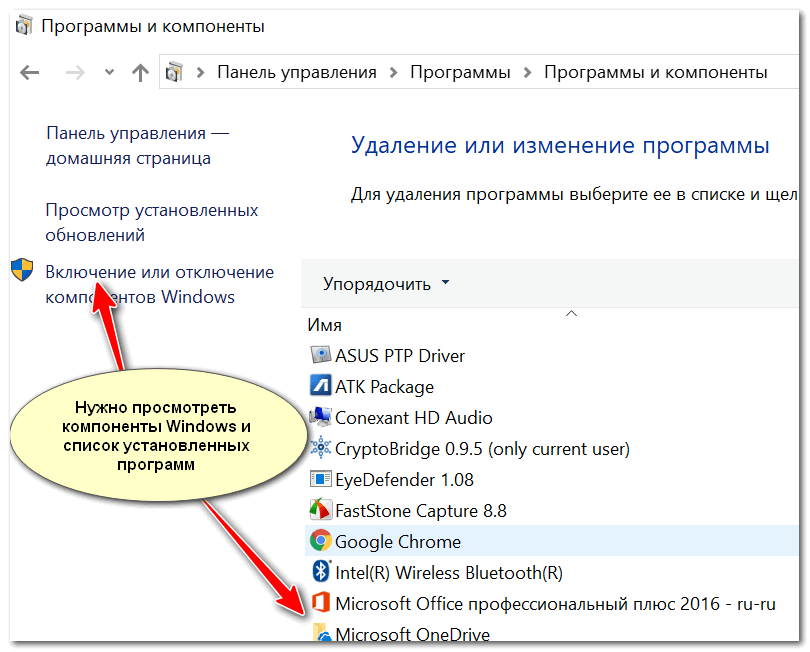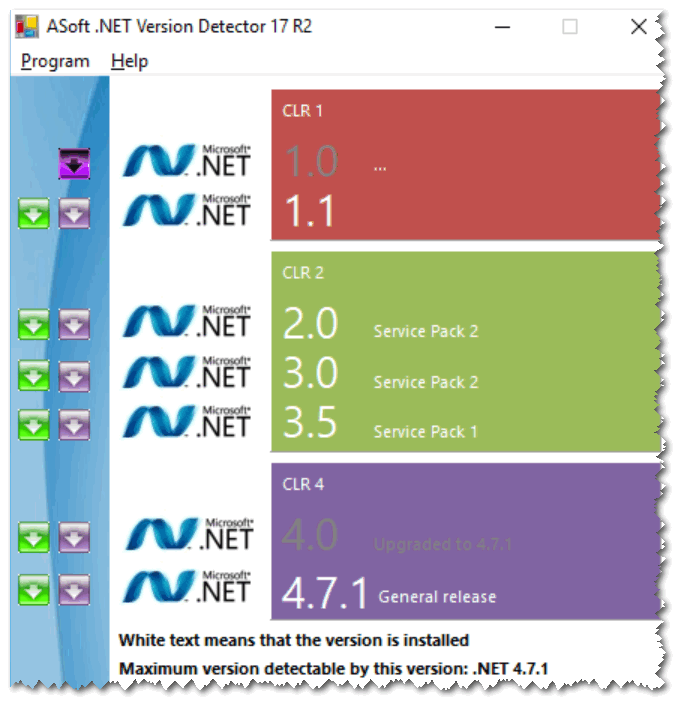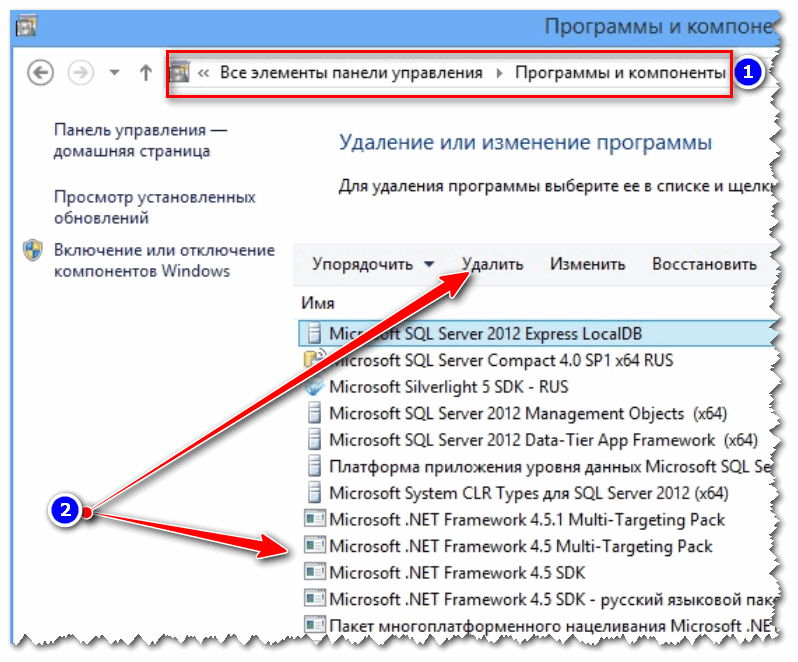For those who have even the slightest understanding of computer software, it is absolutely clear that in any case there comes a time when it becomes necessary to install NET.Framework.
Users often have problems installing and using NET.Framework
This is not surprising at all, since NET.Framework is a framework upon which you can build and then subsequently run some applications. Since Microsoft is the developer of such a platform, it is certainly designed for Windows, although it is still possible to install NET.Framework on some other operating systems, including Linux.
Unfortunately, the installation of the platform is not always successful, users have to face serious problems when system errors occur, due to which the installation process ends with a sudden failure.
Of course, the question immediately arises why Microsoft NET Framework 4 is not installed. Having received an answer to this question, you can find ways to fix the problem.
Inexperienced users who have heard about the possible errors that occur when installing NET.Framework want to know if it is possible to do without installing such a package on a computer. In principle, there is no need to immediately overload the operating system with all sorts of additional applications and programs if the user does not need them. Programmers recommend installing only software that the user directly needs. Excessive loading of the OS with unnecessary programs provokes a shortage of free space on the hard disk, which worsens both the operation of the system and its performance.

By the way, Microsoft initially bundled NET.Framework into the Windows 7 installation package. In addition, the loading of the platform can also be automatically carried out if the user wants to install some game applications, since in this case, the game developers foresee that the game will not be launched without such a platform. In order not to bother the user with additional searches, the installation of the platform is immediately embedded in the game's boot file.
Having understood the algorithm for installing new software, users, by analogy, proceed to install NET.Framework on Windows 7. By performing all the proposed steps in sequence, the user reassures himself that everything will go smoothly, and soon the platform will be successfully installed on Windows 7, after which you can immediately start downloading and then launching your favorite game.
However, in some cases, disappointment arises, because you have to face the fact that even if you strictly follow the instructions, the NET Framework 4 Windows 7 still does not install, displaying a “sad” message on the screen.
The most common cause is a conflict situation that occurs in Windows 7.
Microsoft confirms that the problem that does not install NO Framework 4 on Windows 7 is indeed related to Windows Update.
Of course, if a problem arises, then there is someone who is trying to find ways to solve it. So in this case, programmers have already found effective ways to get around the error that occurs by successfully installing NET.Framework on Windows 7.
At the same time, there is no need to do something incredible, the algorithm for fixing the problem is described in detail, so even those who do not have sufficient practical experience can master it.
"I can't install the NET Framework" is a phrase that many users hear. The combination “I can’t” just flooded thematic forums. Fortunately, there are programmers who, thanks to their excellent knowledge and practical skills, are able to find various options for eliminating errors. In addition, they do not hide their brilliant "finds", but are happy to share with everyone, so on the forums you can often find valuable advice that allows even absolute "dummies" to solve problems.
To install NET.Framework on Windows 7, you must first remove any previous installation traces of all versions. It is quite difficult for inexperienced users to do such manipulations, since Microsoft has tightly “intertwined” the system folders with the platform folders. For this reason, the previous version can be very difficult to remove, or, in general, there is no way to "get rid of" it.
You can’t ignore this step either, because during the new installation of the platform on Windows 7, an error may occur again.
In order for the entire process of uninstallation and subsequent installation to be successful, it is important to follow all the recommendations of experienced users. First of all, it is recommended to download the dotnetfx_cleanup_tool.zip file. Next, it should be opened, and then immediately extracted, since it is placed in the archive.

In the folder where all the extracted files are located, you need to find the cleanup_tool file with the .exe extension. That is what should be launched. A new window will immediately appear asking permission for all subsequent actions. By clicking on the "Yes" button, the user agrees with everything, so the program continues to perform all other actions.
At some point, a window will appear in which you will be offered the right to select the Microsoft product that you want to remove. Among the proposed list there is a line "NET.Framework - all versions", selecting it, it remains to click on the "Clear" button.
However, such an application is not omnipotent, since it will not be able to remove NET.Framework 2.0, since this version of the framework is defined by Microsoft developers as an integral part of the operating system.
After cleaning is completed, the computer must be restarted. Microsoft developers put forward such requirements for many important procedures related to the installation and uninstallation processes.
After starting the operating system, install several versions of Microsoft.NET.Framework in sequence. Initially version 1.1, then go to the installation of versions 3.5 and 3.0, then again you will need to restart the computer.
In conclusion, it remains to enable Windows Update and after that safely install Microsoft.NET.Framework 4.
Despite the fact that it will take some time to perform all the indicated actions, the user can definitely be proud of the result. New knowledge, supported by practical skills, is always considered as a “golden treasure”, which can be useful many more times.
So, despite some difficulties, each user can install the NET.Framework 4 platform on a computer if he believes in his own strength and follows the recommendations of experienced users.
During the launch of some program or at the start of Windows 7 and higher, the user may encounter an error in initializing the .NET Framework 4 platform. It occurs due to incorrect installation of this component or during incompatibility with the operating system itself. Therefore, in order to solve it, it is worth considering several methods.
When running the application on a PC running Windows 7 or later, a message may appear stating "This application must first install one of the following versions of the NET Framework...". In this case, the version of the framework is always indicated.
To solve this problem yourself, you should read the following recommendations.
Method 1: Reinstall the .NET Framework



Now that the system has been cleared of all frameworks, go to the official Microsoft website and click Download the .NET Framework of the version indicated in the error. After downloading the required component, we install it and restart the PC again.
Method 2: Use Official Utilities to Resolve Issues with the .NET Framework
To fix problems with frameworks, Microsoft has released several utilities. Consider the principle of their work in practice.
The first utility is Microsoft .NET Framework Repair Tool. She searches for and fixes problems that are related to frameworks.

To apply it, you should download the file, run it on your PC and accept the terms of the license agreement.

After that, the program will scan the system and offer options for solving the problem. Click "Next" and fix the error.

The second program to solve the file initialization error is the .NET Framework Setup Verification Tool. It checks if the frameworks are installed correctly. At the same time, its use is as simple as possible. You need to download and run the program, specify the version of the frameworks that you want to check and wait for the check results to complete.

The results of the check will be placed in the "Status" field.
The third utility for fixing errors with the .NET Framework is the .NET Framework Cleanup Tool. It will come in handy if you were unable to reinstall the frameworks manually. The utility allows you to remove, re-download and correctly install the missing components.
Therefore, if you yourself were unable to reinstall the frameworks and solve the problem with initializing files, utilities from Microsoft can help solve this problem.
The Microsoft .NET Framework is a special component required for many applications to run. This software is perfectly compatible with the Windows operating system. Why then do errors occur? Let's figure it out.
This issue most commonly occurs when you install the .NET Framework version 4. There can be many reasons for this.
If you do not have the .NET Framework 4 installed on Windows 7, the first thing to check is if it is installed on the system. This can be done using the special utility ASoft .NET Version Detector. You can download it absolutely free of charge on the Internet. We start the program. After a quick scan, those versions that are already installed on the computer are highlighted in white in the main window.

You can, of course, look at the information in the list of installed Windows programs, but the information there is not always displayed correctly.
In different versions of Windows, .NET Framework components may already be embedded into the system. You can check this by going to "Uninstall a program - Turn Windows features on or off". For example, in Windows 7 Starter, I have Microsoft .NET Framework 3.5, as you can see in the screenshot.

In some cases, the .NET Framework is not installed if Windows has not received important updates. Therefore, you need to go to "Start - Control Panel - Update Center - Check for Updates". Found updates will need to be installed. After that, we reboot the computer and try to install the .NET Framework.

Like any other program, the Microsoft .NET Framework has system requirements for a computer to install:
Now let's see if our system meets the minimum requirements. You can see it in the properties of the computer.

Another popular reason why .NET Framework 4 and earlier versions take a long time to install is to update it. For example, I updated my component to version 4.5, and then tried to install the 4th version. I didn't get anything. I received a message that a newer version is installed on the computer and the installation was interrupted.

Very often, when removing one of the versions of the .NET Framework, the rest start to work incorrectly, with errors. And the installation of new ones generally ends in failure. Therefore, if this problem has befallen you, feel free to remove the entire Microsoft .NET Framework from your computer and reinstall it.
You can properly uninstall all versions using the .NET Framework Cleanup Tool. You can easily find the installation file on the Internet.
Choose "All version" and click "Cleanup Now". When the removal is over, we reboot the computer.

Now you can start installing the Microsoft .NET Framework again. Be sure to download the distribution from the official site.
Considering that the .NET Framework, like Windows, is a product from Microsoft, a broken version can be the cause of problems. There are no comments here. Option one is to reinstall the operating system.
That's all, I hope that your problem has been successfully solved
Good day.
It is not uncommon to encounter various errors associated with the Microsoft .NET Framework package (most often in games, various editors, drawing programs, take at least the same AutoCAD ...).
In all such problems, you need to find out which version of the .NET Framework the application needs, see if it is in Windows, and if it is not there, update / install. It would seem that nothing complicated, but there are nuances. They will be discussed in the article ...
For reference. In general, the .NET Framework is a special package that is designed to combine various software written in different programming languages (so that everything works). In theory, you can compare it with codecs. Naturally, if you do not have the required version on your computer (or it has been damaged), then the program will not start for you.
And now, closer to the point, I will analyze the most important thing ...
How do I find out which versions of the .NET Framework I have installed?
Method number 1
You need to open the Windows Control Panel in the following path: (approx. : Installation and removal of programms).

Important!
I note that in Windows 8 and 10 Microsoft .NET is not listed in the list of installed programs (to see the versions, you need to open the link in the menu on the left "View installed updates").
In Windows 10, there is no way to uninstall .NET using standard tools, however, as a rule, it is possible to install the latest version of .NET (update it).

Method number 2
To view and solve problems with .NET, there is a special utility ".NET Version Detector" (available via link: ).
It does not require installation. After launch, it will show a list of all installed versions, as well as links to download them (if suddenly something does not turn out - you can download and install).

Is it possible not to update this package, because I have not updated it before and everything worked?
Most users don't remember it (for the time being...). The fact is that in new versions of Windows there is already a certain version of .NET in the kit (preinstalled in the system) and there is no need to download or update something separately.
In addition, .NET is often included in the installers of popular games, and when they are installed, this package is also updated. Those. all actions are invisible to the user...
However, it may happen that a new program or game will require a new .NET package (or vice versa, you might want to run something old that will require a certain version of .NET and no other).
And then everything is simple: if the required .NET version is not available, then at startup you will see an error (as in the example below). By the way, some of the errors may be related to the "broken" version of .NET (which is why it is sometimes recommended to update this software).

Firstly, I want to advise right away: you don’t need to download all the versions in a row and try to reinstall each one (I’ll note below which versions are recommended for different OSes). Secondly, it is recommended to download .NET only from the official Microsoft website (not a modified installer, so to speak).
Method number 1. A little higher in the article, I recommended that you use the ".NET Version Detector" utility - it will not only show which versions of the .NET package you have installed on your system, but also give links to download each of the versions.
It is important to note that version .NET 4 (let's say) updates the previous version of .NET, so for the new Windows 8, 10, installation (in 99.9% of cases) of only the latest versions of .NET 4 is required.
Addition!
I can not recommend the program - even if you do not need to update the drivers, still try to use it. The fact is that it automatically detects missing components in the system that can affect games (.NET, Visual C ++, and other packages), and installs them. Agree, convenient!

Please note that everything you need for games (.NET, Visual C ++, and other packages) the program downloads and installs automatically!
Is it possible to uninstall the .NET Framework (or use a different version)? What does that require?
In most cases, you don't need to remove the package - you just need to use a different version. You can do this in the tab (which can be opened in the Windows Control Panel - just above in the article shows where to find it) .
Actually, you need to put a "tick" next to the package that you want to use and agree to the changes (Windows may need to download the missing files - it does this itself in auto-mode (just need an internet connection)).

In those cases when you seem to have the required version of .NET installed, but the game (program) still throws errors and "swears" - you can try to remove the .NET package and install it again.
In some cases, the package can be removed by opening the list of installed programs ( Control Panel\Programs\Programs and Features ). Removal occurs in the same way as any other program (see screenshot below).

In some cases, a special utility may be required: NET Framework Cleanup Tool (link to Microsoft Developer Blog - ).
The utility does not need to be installed. By the way, you need to run it as an administrator (approx. : i.e. right-click on the executable file and select "run as administrator" from the context menu) .

That, in fact, is all for today.
Additions are welcome...
All the best.